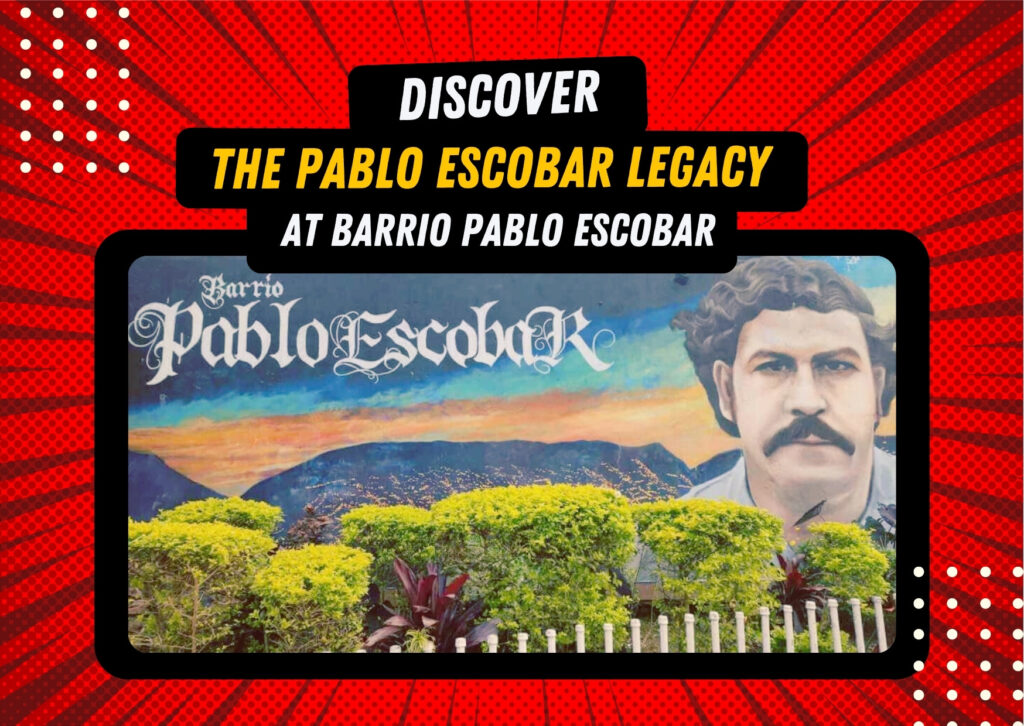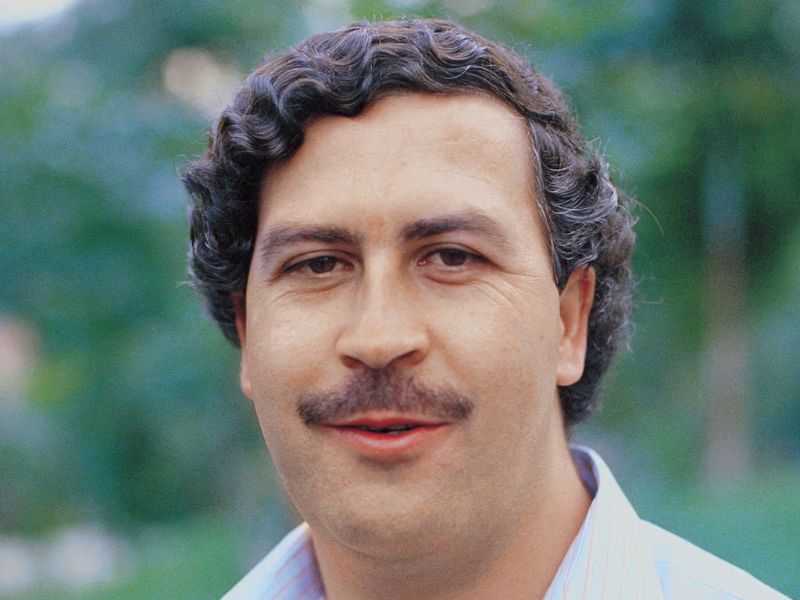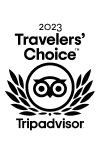Who was Pablo Escobar?
Pablo Escobar’s story is as contradictory as it is infamous. Raised in Rionegro, Antioquia, Escobar climbed the social ladder through a life of crime. He built a drug empire that controlled much of the cocaine trade in the ’80s and ’90s in Colombia. It’s estimated that Pablo sent around 500 kilos of cocaine daily to the United States. With a knack for exporting not just to the U.S. but worldwide, he crowned himself the king of cocaine.
Despite his violence, like ordering the deaths of colonels, police officers, and rival narcos, he managed to gain a “Robin Hood” image among the poor. He funded the construction of houses, churches, schools, and parks in Medellín’s peripheral neighborhoods. During his life, he had a private zoo on his estate, his own prison (La Catedral), private buildings, and ranches.
How did Pablo Escobar become a drug lord?
Born on December 1, 1949, in Rionegro, Antioquia, to Hermilda Gaviria Berrío, a teacher, and Jesus Escobar Echverry, he moved to Envigado at age 11. His childhood was tough since his family didn’t have much money. They came from the countryside. At 18, he finished school and dove into the world of smuggling tobacco, cigarettes, and whiskey. By 21, he was trafficking appliances, knowing routes between Panama, Chocó, and Medellín.
Around this time, Pablo met a Chilean scientist nicknamed “El Cucaracho,” the main drug supplier to the rich. Cucaracho showed Pablo one of the labs he was working in and taught him the entire process of extracting, making, and compressing cocaine. Days later, Escobar decided to set up his own lab and started taking cocaine to Ecuador with an initial load of 20 kg. This led to his arrest and a minor charge. By bribing judges and lawyers to get out of jail, he began building more labs and his cocaine empire.

What was the key to Pablo Escobar’s success in drug trafficking?
One of Pablo’s main keys was using airplanes, having an air fleet known as “the Medellín Cartel airline.” According to the DEA, Escobar had over 15 planes and private jets, flying between Colombia and Florida. In these flights, they would drop cocaine from the plane into Florida’s swamps—a clever way to avoid catching the planes or pilots.
His fleet included planes like the “Canadian ship.” The first plane would leave in the morning and the second in the afternoon, exporting 24 tons of cocaine daily. But Escobar didn’t just use the planes’ cargo; he also hid his goods in the planes’ tires and seats.
Another transportation method was using submarines. He had three submarines with a 5-ton capacity. Their first stop was Panama, backed by General Noriega, then Cuba, and finally Florida. This is how Pablo designed various routes and methods to expand his business, earning him the title of the king of cocaine worldwide.
According to Forbes, Escobar made around $7 billion tax-free from 1981 to 1986. With a net worth of $2 billion and a cash flow of $3 billion, he became the second richest man in Colombia.
What mistakes did Pablo Escobar make that led to his downfall?
Pablo made two mistakes that led to his downfall:
- Getting into politics: In 1982, he was appointed as a representative in the national congress. After several accusations against him, on January 20, 1984, Pablo left politics. But that wasn’t all; the drug lord, already accused of drug trafficking by Justice Minister Lara Bonilla, ordered his assassination. For this and for crimes against colonels, journalists, judges, and police officers, Pablo started a war against the Colombian state from 1984 to 1990.
- Killing his partners, Gerardo “Kiko” Moncada and Fernando Galeano, inside La Catedral in 1992.
How was Pablo’s war with the Colombian State?
Looking at things, Pablo Escobar’s program known as Death to Kidnappers “MAS” represents a phase of great violence in Colombia, establishing an undeclared civil war. MAS wasn’t a single organization but a crisis and crime mentality manifested under private justice. MAS wasn’t a national organization of any affiliation or origin but the diffuse product of a social explosion, with numerous converging interests.
Pablo Escobar and his group of extraditables sought to overturn extradition at all costs. They tried to give their crimes a different political treatment and even dreamed of amnesty. In those days, politicians like Alberto Santofimio Botero defended non-extradition, while politicians like Bernardo Guerra Serna proposed different treatments for their crimes.
Here are some of the murders that marked Colombia’s history:
– In 1985, Pablo Escobar ordered the assassination of Judge Tulio Manuel Castro Gil, who had issued an arrest warrant for the murder of Minister Lara Bonilla.
– On July 30, 1986, Escobar killed Supreme Court Justice Hernando Vaquero Gorda.
– On January 13, 1987, in Medellín, Pablo killed Judge Gustavo Zuluaga Serna, who had issued an arrest warrant for Escobar three years earlier for the deaths of two DAS agents.
– On January 13, 1987, in Bupases, Pablo attempted to kill former Justice Minister Enrique Parejo G., who was the first to approve extradition.
– On March 14, 1989, Magistrate Carlos Ernesto Valencia confirmed the trial against Pablo Escobar. Two days later, journalist Guillermo Cano was assassinated.
– Luis Carlos Galan Sarmiento was assassinated on August 18, 1989, before a speech in Soacha by Medellín Cartel hitmen.
– On March 31, 1991, he ordered the death of former Minister Enrique Low Murtra, a distinguished person for his work.
– Jaime Ramirez Gomez, a police colonel, was killed by Pablo Escobar on November 17, 1986.
– Guillermo Cano Isaza, a journalist known for his columns in El Espectador, was killed by Pablo Escobar on December 17, 1986.
In total, the Truth Commission confirmed that from late 1986 to 1990, Pablo carried out 623 attacks, resulting in 402 civilian deaths, 1,710 injuries, and 550 police deaths.
Pablo Escobar’s Bombs
Pablo’s car bombs were well-known in different cities across the country. From buildings to newspapers, here are the main car bombs:
– On February 16, 1991, right under the San Juan bridge next to the La Macarena bullring, Pablo detonated a car bomb after a bullfight, leaving 22 dead and 128 injured.
– The bomb at El Colombiano newspaper on the night of Thursday, March 10, 1988, when Pablo detonated a bomb at the headquarters.
– Bomb at the Intercontinental Hotel.
– Bomb at the Poblado police station, leaving 4 dead and 97 injured.
– Bomb at El Espectador newspaper.
– Bomb on an Avianca plane, targeting former President Cesar Gaviria.
– Bombs in Cali against rival narcos.
– Bombs targeting public officials.
– On a Saturday night in 1990, at the Oporto nightclub in the Benedictine hill, Pablo’s hitmen killed everyone inside, resulting in 63 deaths. That night, the city witnessed over 100 deaths.
Pablo’s legacy in Colombia is undoubtedly one of sadness. The drug lord marked an important milestone in the country’s history with his evil deeds.
Discover these and more stories on the Pablo Escobar tour, where you can enjoy stories and symbolic characters like Pablo Escobar’s brother, the bear, and his nephew. We’ll also take you to Pablo’s grave, where his cousin and family are buried. Visit the house where he died, we’ll take you to Laureles, the neighborhood where the drug lord was killed. You can see the house from the outside.
Pablo Escobar Tour Medellin: Incredible Transformation

The Legacy of Pablo Escobar Medellin
Pablo Tour: Medellin

What to do on a Pablo Escobar Tour Medellin
Visit Memorial Park, where the Monaco Building was
Go to Pablo Tour grave in Itagui
Escobar’s body rests in a cemetery in Itagui, a suburb of Medellin. His grave is a popular tourist destination, but it is also a place of controversy. Some people believe that Escobar doesn’t deserve the honor. But, others believe that it is important to remember his victims.
Meet the Pablo Tour Neighborhood
Visit the house where Pablo Escobar died
Colombian police killed Escobar in 1993. The house where he died is now a popular tourist attraction. It is a reminder of the violence and bloodshed that Escobar brought to Medellin.
Meet The Cathedral Jail (La Catedral)
Escobar’s prison was a luxury jail called La Catedral in 1991. There, he ran his criminal empire from jail, and he even had a soccer field and a jacuzzi. La Catedral was eventually raided by Colombian police, and Escobar escaped.
Local’s Opinion on Pablo Escobar Tour Medellin
Final thoughts: lest’s see Medellin’s Transformation in a Pablo Tour
If looking for another type of tour for your next trip to Medellin, be sure to contact us today.



